Parent page: Workspace Content Types
Altium Designer, in conjunction with your connected Workspace, caters for the ability to create and manage reuse blocks (Reuse Block Items) in that Workspace. Such blocks are created directly within the Workspace. Once a reuse block has been created (and data saved into a revision of it), it can be reused in future board-level design projects.
Folder Type
When creating the folder in which to store reuse blocks, you can specify the folder's type. This has no bearing on the content of the folder – saving a reuse block will always result in a corresponding Reuse Block Item. It simply provides a visual 'clue' as to what is stored in a folder and can be beneficial when browsing a Workspace for particular content. To nominate a folder's use as a container for reuse blocks, set its Folder Type as Design Reuse Blocks, when defining the folder properties in the Edit Folder dialog.
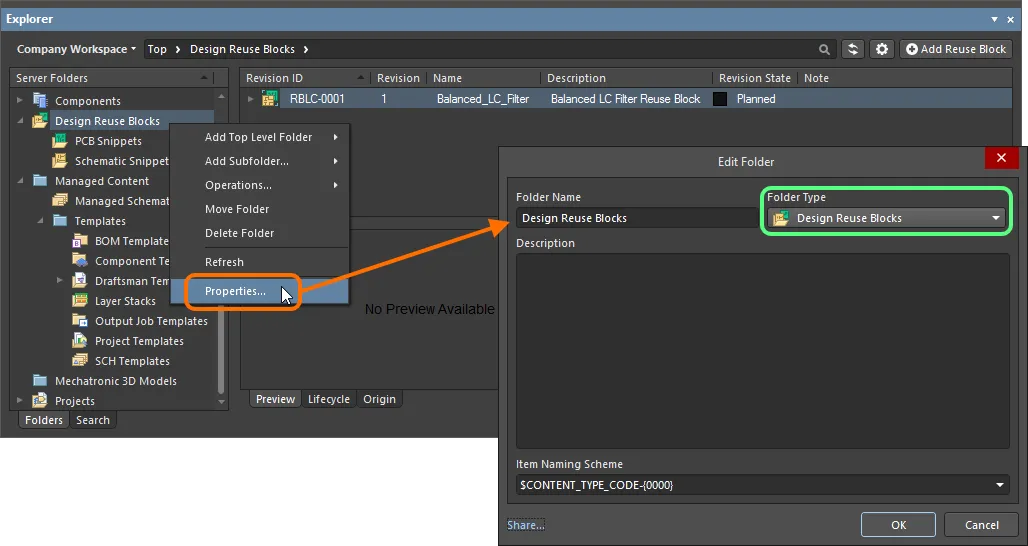
Specifying the folder type – its intended use – gives a visual indication of the content of that folder when browsing the Workspace.
Item Naming Scheme
Another important aspect of the parent folder is the Item Naming Scheme employed for it. This defines the format of the unique ID for each Item created in that particular folder. Several default example schemes are available, utilizing the short-form code for either the folder type (RBLC – Reuse Block Collection) or the content type (RBL – Reuse Block):
$CONTENT_TYPE_CODE-001-{0000} – for example, RBL-001-0001.$CONTENT_TYPE_CODE-001-{A00} – for example, RBL-001-A01.$FOLDER_TYPE_CODE-001-{0000} – for example, RBLC-001-0001.$FOLDER_TYPE_CODE-001-{A000} – for example, RBLC-001-A001.
Using a default naming scheme, the software will automatically assign the next available unique ID, based on that scheme, having scanned the entire Workspace and identifiers of existing content. This can be a great time-saver when manually creating reuse blocks.
A custom scheme can also be defined for a folder by typing it within the field, ensuring that the variable portion is enclosed in curly braces (e.g. REUSEBLOCK-001-{0000}).
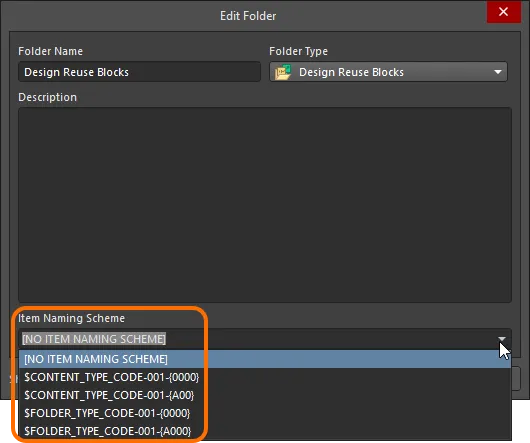
The Item Naming Scheme of the parent folder is applied to the Unique ID for each Item created within that folder.
The Item Naming Scheme employed for the parent folder can be changed at any time. The modified scheme will then be applied to any subsequent newly-created content within that folder.
Content Type
When creating a target Reuse Block Item in which to store your reuse block, ensure that its Content Type is set to Reuse Block, in the Create New Item dialog. If you are creating the Item in a Design Reuse Blocks type folder, this content type will be available from the right-click context menu when creating the Item.
A Workspace supports item-less reuse block creation. Using the
Create Item » Reuse Block command from the right-click menu will enter this mode directly. To get the
Create New Item dialog first, you need to use the
Create Item » Other Item Type command. For more information about the former, see
Item-less Reuse Block Creation.
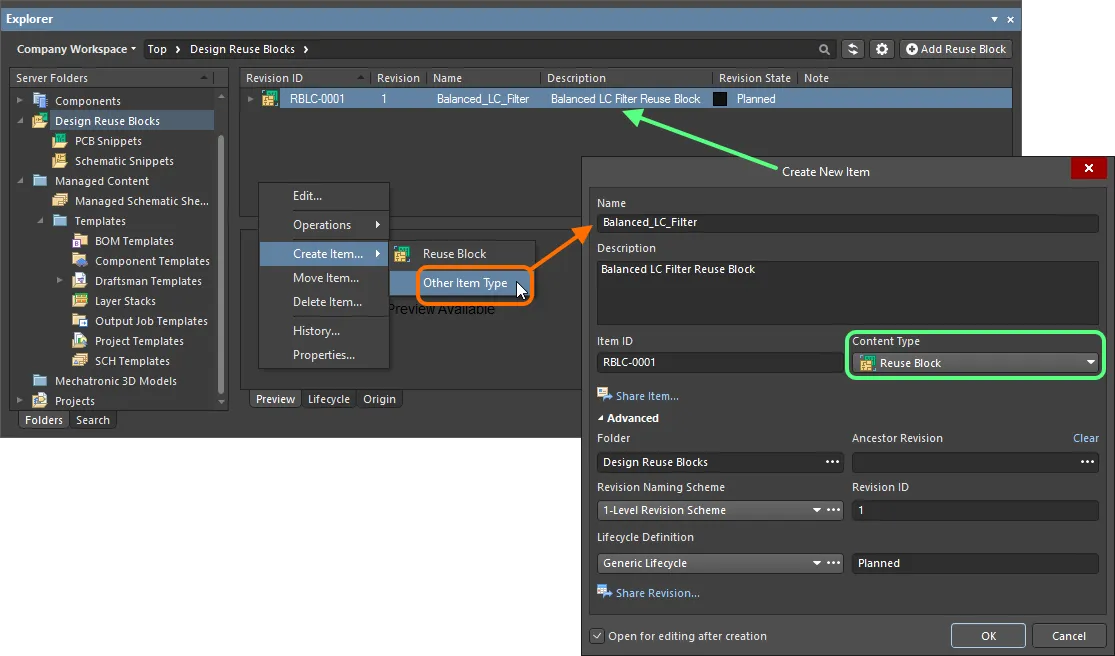
Creating a reuse block within a Design Reuse Blocks folder – while the correct Content Type is available on the context menu (Reuse Block command), using this will take you into item-less reuse block creation mode. To create a traditional Item using the Create New Item dialog, choose the Other Item Type command from the menu instead.
Item Lifecycle Definition and Revision Naming
Related pages: Defining Revision Naming Schemes for a Workspace, Defining Lifecycle Definitions for a Workspace
When defining a reuse block, be sure to specify the type of lifecycle management to be used for the reuse block, and the naming scheme employed for its revisions, respectively.
Control over which content types can use a particular lifecycle definition or revision naming scheme, can be defined and enabled at a global level from within the Content Types dialog, when defining each schema. The default schemes assigned for use by a reuse block are: Generic Lifecycle and 1-Level Revision Scheme, respectively.
Once a reuse block has been saved into the initial revision of a Reuse Block Item, these schemes cannot be changed for that particular Item.
Specify the required schemes in the Create New Item dialog, using the Lifecycle Definition and Revision Naming Scheme fields respectively.
If the option to control use of lifecycle definitions and revision naming schemes per content type is enabled for any definitions/schemes, and the Reuse Block content type is not set to use a particular definition/scheme, then that definition/scheme will not be available in the applicable drop-down list.
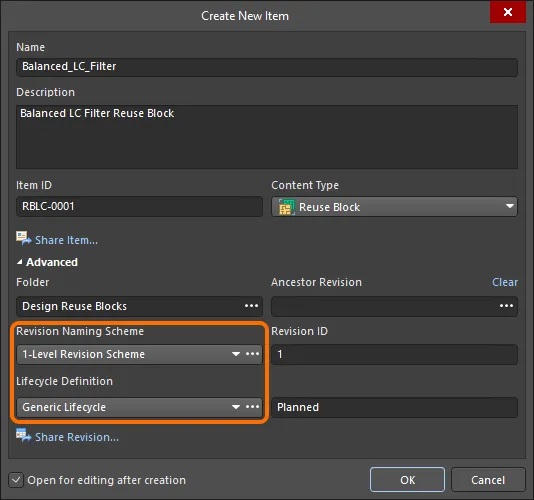
Selecting the Lifecycle Definition and Revision Naming schemes for a manually created reuse block.
Observing standard revision naming schemes and lifecycle definitions, across the various types of design content in a Workspace ensures smooth, consistent management of this content.
It is a good idea to add a Name and Description as part of the reuse block's definition. This information is used when searching the Workspace and enables quick identification of what a reuse block offers.
Saving a Reuse Block
Related page: Creating and Editing Content Directly through a Workspace
So far, we've discussed the support for a reuse block in the Workspace, in terms of related folder and content types. Saving an actual defined reuse block into a revision of a Reuse Block Item can be performed in a streamlined way.
A reuse block can be edited and saved into the initial revision of a newly-created Reuse Block Item, courtesy of the Workspace's support for direct editing. Direct editing frees you from the shackles of separate version-controlled source data. You can simply edit a supported content type using a temporary editor loaded with the latest source direct from the Workspace itself. And once editing is complete, the entity is saved (or re-saved) into a subsequent planned revision of its parent Item, and the temporary editor closed. There are no files on your hard drive, no questioning whether you are working with the correct or latest source, and no having to maintain separate version control software. The Workspace handles it all, with great integrity, and in a manner that greatly expedites changes to your data.
When you create a Reuse Block Item, you have the option to edit and save the reuse block into the initial revision of that Item, after creation. To do so, enable the Open for editing after creation option, at the bottom of the Create New Item dialog (which is enabled by default). The Item will be created and the temporary editable project in the Projects panel (under an entry for the Workspace you are currently connected to), and the temporary schematic editor will be opened in the main design window, ready for defining the schematic model of the reuse block. The project will be named according to the Name specified in the Create New Item dialog.
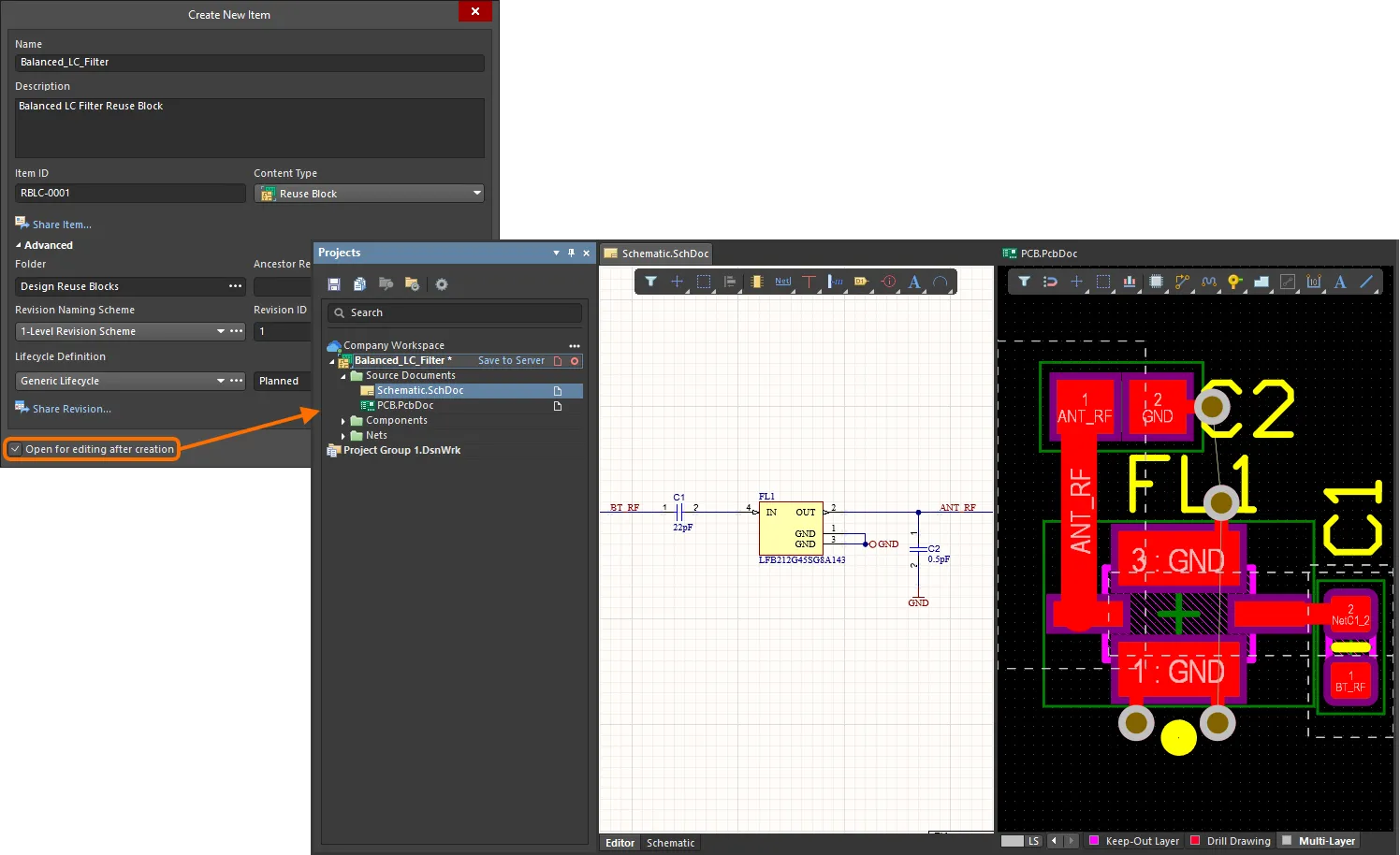
Example of editing the initial revision of a reuse block, directly from the Workspace – the temporary editable project is opened in the Projects panel, ready for you to define the reuse block as required.
Define reuse block content as required. Because reuse blocks are stored in a Workspace, the components on them should also be stored in the Workspace. That way, you get the full benefit of the content system that the Workspace provides. You can start with defining the schematic model of the reuse block then use the Design » Update PCB Document command and the standard ECO process to transfer the captured schematic to the PCB model of the reuse block then apply the changes needed to that model (defining component locations, routing, etc.).
- Both schematic and PCB models of the reuse block must contain at least one component in order for being able to be saved to the Workspace.
- If the reuse block's schematic and PCB documents are not synchronized (differences between the schematic and PCB documents are detected), the warning dialog will be shown when trying to save the reuse block to the Workspace. You can cancel saving to return to the reuse block and address the differences or proceed with saving.
There are three relevant controls when direct editing, readily available from the Quick Access Bar (at the top-left of the main application window):
-
 – Save Active Document. Use this button to locally save any changes made to the currently open document of the reuse block. This allows you to save current changes, should you wish to come back at a later stage to make further changes before ultimately saving to the Workspace.
– Save Active Document. Use this button to locally save any changes made to the currently open document of the reuse block. This allows you to save current changes, should you wish to come back at a later stage to make further changes before ultimately saving to the Workspace.
-
 /
/ – Save to Workspace. Use this button to save the defined reuse block to the Workspace, storing it within the initial (planned) revision of the target Reuse Block Item. The Edit Revision dialog will appear, in which you can change Name, Description, and add release notes as required. The editor will close after the save. The source reuse block definition will be stored in the revision of the Item.
– Save to Workspace. Use this button to save the defined reuse block to the Workspace, storing it within the initial (planned) revision of the target Reuse Block Item. The Edit Revision dialog will appear, in which you can change Name, Description, and add release notes as required. The editor will close after the save. The source reuse block definition will be stored in the revision of the Item.
A
Save to Server control is also conveniently provided to the right of the reuse block's entry, within the
Projects panel itself.
-
 /
/ – Discard Local Changes. Use this button if you wish to cancel editing and discard any changes made. The editor will close, and nothing will be saved to the target Reuse Block Item.
– Discard Local Changes. Use this button if you wish to cancel editing and discard any changes made. The editor will close, and nothing will be saved to the target Reuse Block Item.
These controls are also available as commands – Save (shortcut: Ctrl+S), Save to Server, and Discard Local Changes – from the main File menu and from the right-click menu of entries of the reuse block and its documents in the Projects panel.
The saved data stored in the Workspace consists of the schematic and PCB models. In the Explorer panel, switch to the Preview aspect view tab to see these models.
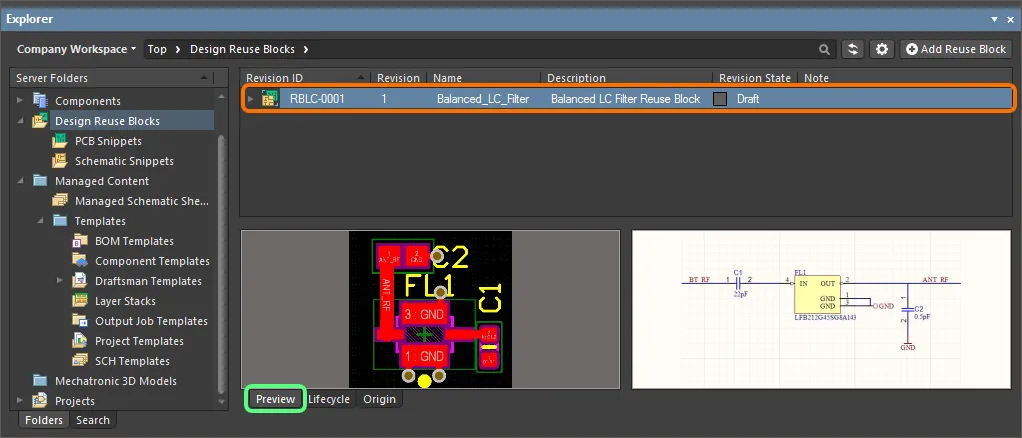
Browse the saved revision of the reuse block, back in the Explorer panel. Switch to the Preview aspect view tab to see the reuse block's models.
Item-less Reuse Block Creation
The Workspace, in conjunction with Altium Designer, supports Item-less reuse block creation. This does not mean an item is not created, but rather the temporary editable project is accessed directly, which allows the reuse block details to be applied prior to adding and saving the required reuse block. The actual Reuse Block Item (and planned revision) is created as part of release preparation.
From the Explorer panel, Item-less reuse block creation is available from within an existing folder for reuse blocks (folder type must be Design Reuse Blocks). There are two ways to enter item-less reuse block creation mode:
- By using the Create Item » Reuse Block command from the Item region's right-click menu.
- By clicking the
 button, located at the top-right of the panel.
button, located at the top-right of the panel.
A new reuse block can also be created in this manner by using the File » New » Reuse Block command.
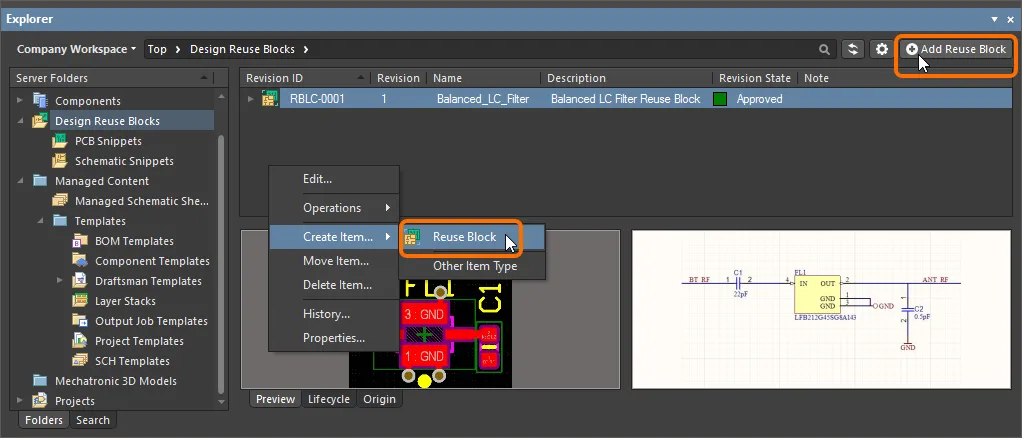
Accessing Item-less reuse block creation mode from within the Explorer panel. The current folder must be of type Design Reuse Blocks.
Make any adjustments to the reuse block as required. With the reuse block defined, click the  /
/ button (on the Quick Access Bar) to save the reuse block to the Workspace. The New Reuse Block dialog will appear, in which you can specify Name, Description, and Workspace folder as required. The temporary editable project will close after the save.
button (on the Quick Access Bar) to save the reuse block to the Workspace. The New Reuse Block dialog will appear, in which you can specify Name, Description, and Workspace folder as required. The temporary editable project will close after the save.
Your new reuse block will be available to view in the Explorer panel, and also to browse for and work with, through the Design Reuse panel.
Reusing a Reuse Block
Related pages: Controlling Access to Workspace Content
Once a reuse block has been saved to a Workspace, and its lifecycle state set to a level that the organization views as ready for use at the design level, that block can be reused in future board-level design projects. And keeping to the use of the Workspace as the source of all content in and for a design, it is good practice to reuse your reuse block content in Workspace Projects – which themselves are under the Workspace's wing.
Using
controlled access to Workspace content, in conjunction with a suitable lifecycle schema, authorized personnel (librarians, senior design management) can ratify, and make available, only those reuse blocks that are to be used in designs. This allows you to design away, reassured that you are using only those reuse blocks authorized to be used.
Placement of a reuse block is performed from Altium Designer's Explorer panel or Design Reuse panel.
Prior to placement of a reuse block, ensure that the desired document that is to receive the associated reuse block is open in Altium Designer and is the active document. Depending on the type of the document (schematic or PCB), the reuse block's schematic or PCB model will be placed when using the place command.
To place a revision of a reuse block from the Explorer panel:
- Browse or search for the reuse block you wish to place.
- Right-click on the specific revision of the reuse block required (typically the latest, in which case just right-click directly on the top-level Item entry).
- Choose the Place command.
To place the latest revision of a reuse block from the Design Reuse panel:
- Browse or search for the reuse block you wish to place.
- Click within the reuse block tile and click the Place button. Alternatively, click the
 button within the tile (or right-click anywhere on the tile).
button within the tile (or right-click anywhere on the tile).
- Choose one of the following commands:
- Place – select to place the reuse block directly on the active schematic or PCB document.
- Place as Sheet Symbol – when a schematic document is active, select to place the reuse block as a Sheet Symbol on the schematic sheet. The content of the reuse block will be placed on an automatically created child schematic sheet referenced by the placed Sheet Symbol.
Re-Saving a Reuse Block
At any stage, you can come back to any revision of a reuse block in the Workspace, and edit it directly. Right-click on the revision in the Explorer panel and choose the Edit command from the context menu. Once again, the temporary editable project will open for editing. Make changes as required, then save the project into the next revision of the reuse block.
Right-clicking on the top-level entry for a reuse block itself will edit the latest revision of that block. Also, the latest revision of a reuse block can be opened for editing from the
Design Reuse panel by clicking the

button within the reuse block tile (or right-click anywhere on the tile) and selecting the
Edit command.
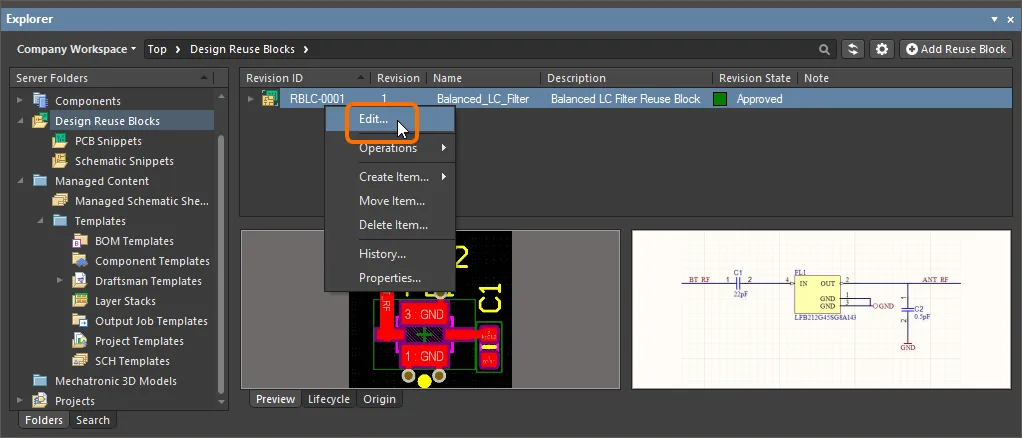
Accessing the command to launch direct editing of an existing revision of a reuse block from the Explorer panel.
Downloading Saved Data
Download the data stored in a revision of a reuse block by right-clicking on that revision and choosing the Operations » Download command from the context menu. The applicable schematic and PCB files will be downloaded into a sub-folder under the chosen directory, named using the Item Revision ID. The file can be found in the Released folder therein.
Access the Download command from the top-level entry for a reuse block itself, to download the applicable files stored in the latest revision of that block.
Soft Deletion
When connected to a Workspace, flexible functionality is available for removing a reuse block directly from within Altium Designer:
- From the Explorer panel – right-click on the reuse block's entry in the panel and choose the Delete Item command from the context menu.
- From the Design Reuse panel – click the
 button within the reuse block's tile (or right-click anywhere on the tile) and select the Delete command from the context menu.
button within the reuse block's tile (or right-click anywhere on the tile) and select the Delete command from the context menu.
The Delete Items dialog will appear, in which to confirm the deletion. The action is actually a 'soft delete', whereby the reuse block will be moved into the Trash area of the Workspace. The Trash is essentially a recycle bin into which any content within your Workspace can be moved (through a soft delete action). It is isolated from the rest of the Workspace.
With the soft-delete facility, you are able to delete a reuse block that is currently being used.
Multiple reuse blocks can be deleted from within the Explorer panel in a single action. Select all required reuse blocks using standard multi-select controls (Shift+Click, Ctrl+Click), then right-click and choose the Delete Items command from the context menu.
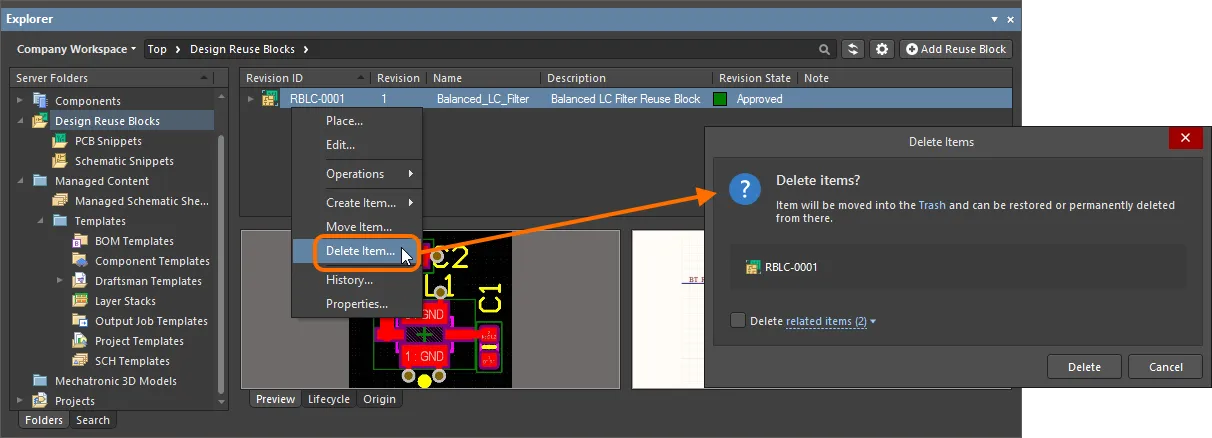
Soft deletion of a reuse block from within the Explorer panel. The content will be moved to the Workspace's Trash area.
To proceed with the deletion, click the  button. The content will be removed and a Deletion Summary dialog will confirm successful deletion. If there was an issue with deletion, this will be flagged to you.
button. The content will be removed and a Deletion Summary dialog will confirm successful deletion. If there was an issue with deletion, this will be flagged to you.
The content deleted in this manner can be found on the Trash page of the Workspace's browser interface. Note that you can only view the content that you have personally soft deleted. Administrators will be able to see the full content of the Trash page – so all content that has been soft deleted.
Things to consider in relation to a soft deleted reuse block:
- The reuse block will not be available from your design software, or from within the Web interface.
- Anywhere the reuse block was being used will reflect that the reuse block has been deleted.
- A reuse block can be restored, or permanently deleted from the Trash page, provided you have editing rights. Permanent deletion is only possible provided it is not being used by a parent Item.
Note that if you have soft deleted a reuse block – moving it to the Trash – you can create a new reuse block with that same name again. If you were to subsequently restore the original reuse block, and the original name is taken, an integer suffix will be used, to keep its name unique within the Workspace.
